
|
|
General Information
The Indian Rhinoceros, also known as the greater one-horned Asian rhino, is a large species of rhino with skin divided by thick folds at the shoulder joints and flanks, giving it an armor-plated appearance.
Next to the elephant, the Indian rhino is the largest land animal in Asia--6 feet (2 m) tall at the shoulders and up to 4000-5000 pounds (1,800 to 2,200 kg) in weight.
At birth, an Indian rhinoceros weighs about 90 pounds (40 kg). In spite of their bulk, they are surprisingly nimble and quick.
The Indian rhino may charge at 30 miles (48 km) an hour. They have poor eyesight but well-developed sense of hearing and smell.
The Rhino Horn
The Indian Rhino differs from the other types of rhino in that it only has
one large horn, not unlike the unicorn.
The horn is not a true horn, but is made of thousands of tiny strands of compressed hair or keratin, the same material that makes up human fingernails..
Habitat
The Indian rhino is a forest dweller and is also an excellent swimmer that
will cross wide rivers. It prefers to be near swamps and rivers since it needs
to spend a great deal of time in water or mud to protect its skin. This rhino was once found throughout most of northern India, Pakistan, and
Nepal, particularly in lush river valleys. Today, it survives only on eight
reserves in India and Nepal. Living in swampy areas, it eats marsh grasses and aquatic plants. Strict
protection in these reserves has helped the population to rebound from under
200 to about 2000.
Feeding and Breeding
The Indian Rhino feeds on grasses, fruit, leaves, tree and shrub branches, and cultivated crops using its prehensile upper lip.
A male and female rhinoceros may remain coupled for over an hour for successful breeding. The baby rhinoceros is born after a gestation of approximately 16 months.
Females sexually mature at 5 to 7 years of age; males at 10 years and they have a life span of approximately 47 years (in captivity).
Social Behaviour
Aside from a cow and calf pair, Greater one-horned rhinos are basically solitary
animals. Occasionally temporary groups will form. Greater one-horned rhinos
will become highly aggressive towards one another if their population density
becomes too high. Dominant bulls are usually the aggressors.
There are dominant and inferior bulls in the Greater one-horned rhino social hierarchy. However, they usually do not live in a fixed home range that they defend as a strictly defined territory.
The continuous seasonal changes make it virtually impossible for a bull to defend a strictly defined territory.
A bull will, however, enforce dominance as he shifts his main areas of activity. He will scent mark his area and challenge other dominant or inferior bulls as they approach.
Conservation
All of the world's rhino species are endangered and today fewer than 14,000 rhinos are found throughout the world.
Of that, fewer than 2,400 Greater one-horned rhinos presently remain in the wild. The Indian rhinoceros population in the wild is endangered due to hunting and increasing human population
Threats to survival
Greater one-horned rhinos are endangered due to poaching and habitat loss.
The rhinoceros is hunted for the alleged symbolic and medical qualities of
its horn.
The horns are used for traditional Asian medicines and to make dagger handles in Yemen. In fact, the Indian Rhino horn fetches a higher price than the African ones. Indian rhinos are also threatened by habitat loss.
India and Nepal are very densely populated areas and the ever-increasing human population continues to encroach on wildlife habitat. The floodplains where the rhinos live are often used for agriculture.
The remaining areas of the flood plains are subject to severe floods and are not suitable year-round habitats for the rhinos. Continued destruction of forests increases the severity of the annual flooding.
Efforts to save Greater One-Horned Rhinos
While Greater one-horned rhinos are still threatened with extinction, their
numbers are up from an all time low of 900 individuals in 1970. The rhinos
are important in rites accompanying the accession of kings in Nepal.
Over 400 rhinos are guarded in the Royal Chitwan National Park in Nepal. A second population of rhinos has been established in Royal Bardia National Park in southwestern Nepal.
Although the Nepalese government has provided guards for the parks, some poaching still occurs.
The American Zoo and Aquarium Association has a Species Survival Plan organized for the Greater one-horned rhino. SSPs are special programs designed by a team of zoo and wildlife professionals.
The plans outline breeding plans, work to increase public awareness and education, help conduct research, and in some cases, organize programs to reintroduce captive-bred wildlife into secure habitats.
Interesting Facts
Rhinos enjoy wallowing in the mud. The mud creates a coating on their skin to protect them from sunburn and insect bites. Mud wallowing is also an effective method of heat loss.
Scent marking is important in rhino communication. Greater one-horned rhinos mark the paths of their territories with secretions from special glands that are found above and behind the ball of the foot on all 4 legs.
Rhinos will also mark their areas with urine or dung.
Bibliography
http://www.rhinos-irf.org/rhinos/indian.html
http://www.nature.ca/notebooks/english/indrhino.htm
This website is best viewed using Internet Explorer at 800 X 600 resolution